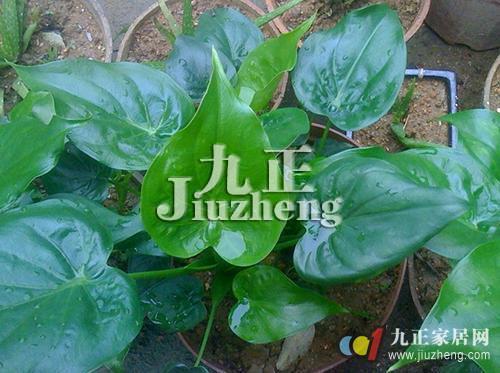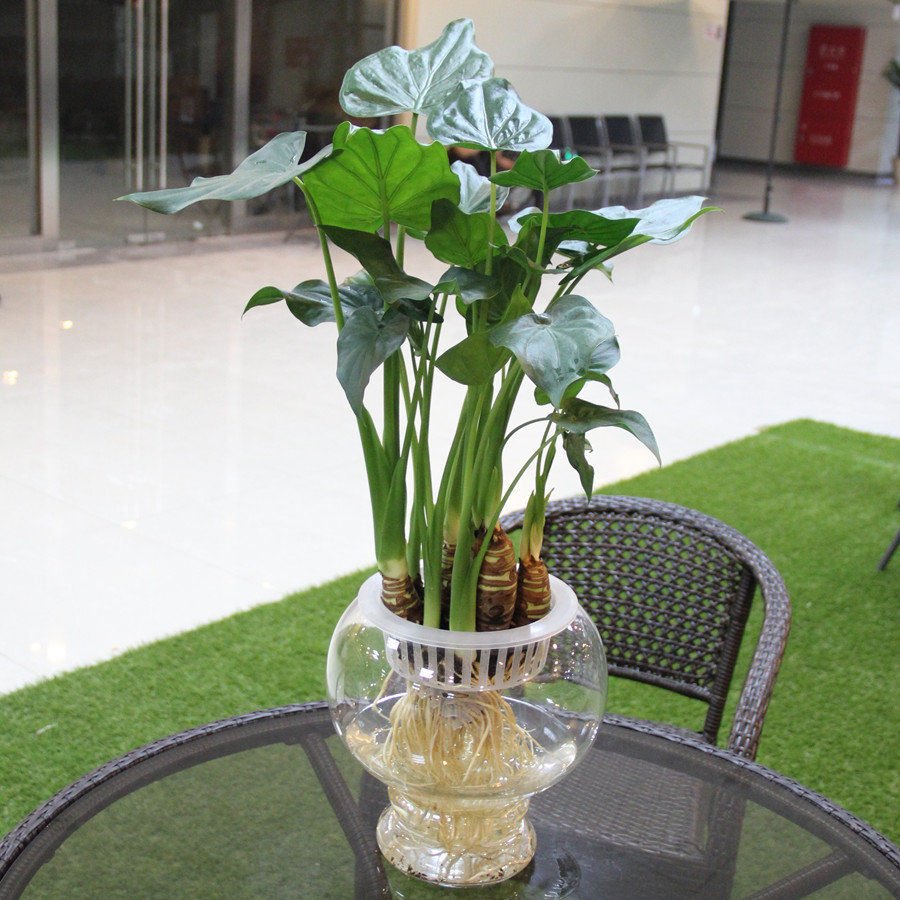How to maintain Dizhui Guanyin
The scientific name "Dishui Guanyin" is sea taro. Originally from the tropical rainforest of South Africa, if it is allowed to grow in a moist and warm environment, there will be drops of water on the edge of the leaves, so it is called "dripping Guanyin". When raising Guanyin, you should pay attention to the following aspects:
(1) temperature dripping Guanyin can only grow well at an environment of not less than 18 ℃. If the temperature is lower than 18 ℃, dripping Guanyin will be dormant and stop growing.
(2) dripping light, Guanyin likes Yin, and avoid direct sunlight.
(3) fertilization dripping Guanyin likes fertilizer, dripping Guanyin becomes "wilted", mainly due to insufficient fertilization, therefore, it should be fertilized every month according to the growth situation.
(4) Water dripping Guanyin will drip along the leaves. This characteristic makes many people think that dripping Guanyin must like to "drink water", but in fact, dripping Guanyin is not always "thirsty". It can be watered once a week. Be careful not to spray water on the leaves of dripping Guanyin. The water in the north is alkaline. Spraying water will make white spots appear on the leaves.
How to cultivate dripping Guanyin? how to cultivate dripping Guanyin leaves with yellow and rotten roots?
The bulbs and leaves of dripping Guanyin can be used medicinally, but they are highly toxic and their leaf juice will be poisoned at the entrance, so it is not suitable to raise Dishui Guanyin if there are pets or children at home, so as to avoid tragedy. This is an extra point to pay attention to in aquaculture Di Shui Guanyin. Now let's learn about the culture method of Dishui Guanyin.
How to cultivate the rotten roots of Dishui Guanyin?
Dishui Guanyin leaves are thick and bright, suitable for display in the living room. It is a large ornamental indoor foliage plant, and many people will breed it at home. But how does Dishui Guanyin breed? What about dripping Guanyin rotten roots? Next, I would like to introduce the method of Dishui Guanyin culture, as well as the reasons and solutions of Dishui Guanyin rotting roots.
How to cultivate Guanyin in Dishui
1. Matrix preparation
Cultivated in a nutritious soil mixed with loose, drained and well-ventilated domestic peat, 2:2:1 pond mud, peat soil, coarse sand and a small amount of retted cake fertilizer, mix the peat with water, (standard of adding water: after mixing well with water, hold a handful of peat in hand, and water seeps from fingers) to be planted in last cup.
2. Upper basin
The old pots that are reused must be soaked in potassium permanganate 2000 times solution for more than half an hour, then rinsed with clean water and dried for use. Large potted plants are generally used for 20cm pot planting, when planting, first in the bottom of the cup cushion 4cm around the matrix, and then move the sieve seedlings into the cup, seedling planting should not be too deep, flat planting base is appropriate; medium tightness, loaded to the cup 8 minutes full, 2-3 plants / pot.

3. Spray water
Dishui Guanyin especially likes to be wet. During the growing season, not only the basin soil is wet, but also the air humidity is not less than 60%. When it is hot in summer, it is necessary to strengthen water spraying to create a relatively cool and humid environment, which is placed in the indoor air-conditioned hall, not only to ensure that the basin soil is moist, but also to spray water on the leaf surface from time to time. If the room temperature can not reach 15 ℃ in winter, watering should be controlled, otherwise it is easy to cause rotting roots. In general, spraying warm water once a week can keep the leaf color thick green.
4. Fertilization
Dishui Guanyin prefers fertilizer. Liquid fertilizer should be applied every half a month from March to October, in which the proportion of nitrogen can be appropriately increased. If you can add a little ferrous sulfate, the leaves will grow as big as lotus leaves, smooth and pleasant. Fertilization should be stopped when the temperature is below 15 ℃.
5. Pruning
Because Dishui Guanyin is a foliage plant, in the case of improper planting and maintenance, the largest leaves will turn yellow and dry. At this time, they should be cut off with a knife together with the stem, otherwise it will affect the growth and ornamental quality of other leaves.
6. Change the basin
It can be cultivated in nutrient soil mixed with rotten leaf soil, peat soil, river sand and a small amount of retting cake fertilizer, or hydroponic, but attention should be paid to anti-rotting roots and adding nutrient solution. Usually change the basin once a year in spring, but loosen the soil once a month to keep the basin soil in a good state of permeability.
What about the rotten roots of dripping Guanyin
The reason for the rotting root of dripping Guanyin
Dishui Guanyin is divided into soil culture and water culture.
The soil dripping Guanyin rotten root is mainly caused by dripping Guanyin basin soil is too wet. If the basin soil is too wet, it is easy to rot the roots of dripping Guanyin. The reason why the basin soil is too wet may be that you water too much, resulting in stagnant water in the basin, or it may be that the soil is sticky, poor air permeability, and it is easy to accumulate water.
The phenomenon of root rot often occurs in dripping Guanyin mainly because the tissue of dripping Guanyin stem is relatively loose. if the water quality is very poor, it may cause rotting root and stem rot.
The solution of dripping Guanyin rotting Root
The solution to the rotten roots of dripping Guanyin is as follows: pull up the dripping Guanyin, cut off the rotten roots, and cut off a little of the healthy tissue near the rotten part to make sure that what is left is white. After cutting the root, pay attention to dry it, wait for the wound to heal, and then plant it in a well-drained, fertile, acidic soil. You can also apply some plant ash to the wound for disinfection and sterilization.
It should be noted that the juice of dripping Guanyin is poisonous and you should wear rubber gloves when cutting the roots to prevent yourself from poisoning. After dripping Guanyin is planted in the soil, remember to dry thoroughly and then water it, so that it will not be dry or watered. In addition, put it in a ventilated place for breeding.
Hydroponic dripping Guanyin rotten root should remove its root rot, wash the mucus from the tuber and root system, and change water or nutrient solution. Pay attention to keep the bottle water clean when breeding.
The above is for everyone to introduce the method of Dishui Guanyin culture, as well as the reasons and solutions for the rotten roots of Dishui Guanyin. Do you all understand? Please pay attention to more household knowledge.
- Prev

How does Dishui Guanyin grow in water?
Dishui Guanyin, also known as sea taro and Guangdong wolf venom, is an evergreen herb of the Araceae family, originating in the south and southwest of China. The plant is large, up to 3 meters high, likes warm and humid environment, the suitable temperature for growth is 25-30 ℃, the best overwintering temperature is more than 10 ℃, and it can also withstand a low temperature of about 5 ℃.
- Next

How to make the triangular plum bonsai blossom full of trees?
Triangular plum bonsai in maintenance is often due to excessive water and fertilizer, exuberant branches and leaves, resulting in less flowering or non-flowering phenomenon. Although the branches are more ornamental, the ornamental value will be higher if there are flowers. In order to make the triangular plum bonsai blossom full of trees and achieve a better ornamental effect, efforts should be made on sunshine, water and fertilizer and pruning in the maintenance process.
Related
- Fuxing push coffee new agricultural production and marketing class: lack of small-scale processing plants
- Jujube rice field leisure farm deep ploughing Yilan for five years to create a space for organic food and play
- Nongyu Farm-A trial of organic papaya for brave women with advanced technology
- Four points for attention in the prevention and control of diseases and insect pests of edible fungi
- How to add nutrient solution to Edible Fungi
- Is there any good way to control edible fungus mites?
- Open Inoculation Technology of Edible Fungi
- Is there any clever way to use fertilizer for edible fungus in winter?
- What agents are used to kill the pathogens of edible fungi in the mushroom shed?
- Rapid drying of Edible Fungi

